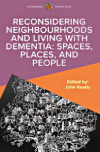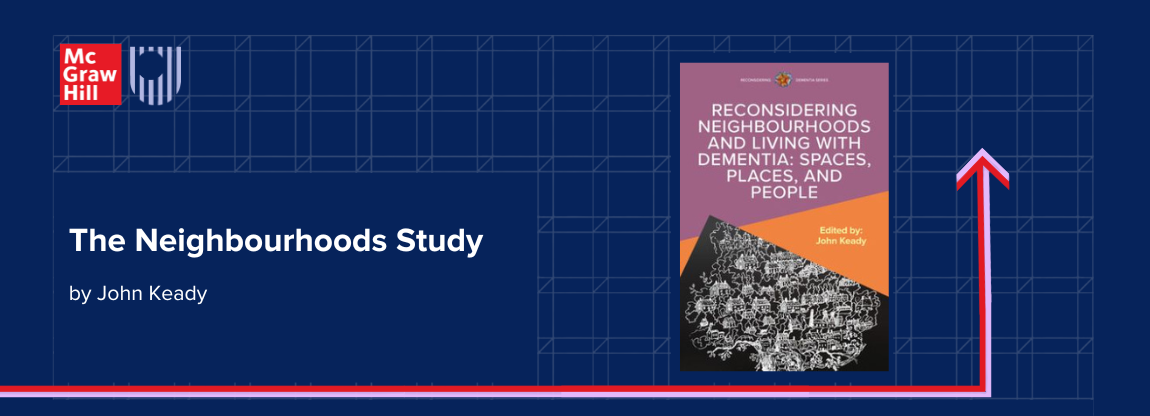The Neighbourhoods Study
Why focus on neighbourhoods?
This is a question I am often asked when talking to others about the book and its contents. My reply can best be summarised in three short statements:
First, as the editor, I wanted the book to tell the story of our five-year (2014-2019) ‘Neighbourhoods and dementia study’ and for each of its 13 chapters to showcase the mixed methods that underpinned the work. The book also includes representation from all eight research programmes on the ‘Neighbourhoods and dementia study’ and contributions from each of the four successful PhD students who undertook their research on the study. The book draws on research that took place in England, Scotland, and Sweden and often includes cross-national working to reveal the similarities, and at times the differences, in the meaning of a neighbourhood for people living with dementia.


Second, as far as it was possible, we wanted people living with dementia to tell their own story about their own neighbourhood and to communicate that experience in whatever medium was most accessible and relevant. In the event, people living with dementia shared stories about their neighbourhood in words, drawings, photographs, videos, music, map-making, sign language, and the use of animation.
Third, whilst recollections of a neighbourhood meant different things to different people, in the opening chapter of the book, people living with dementia offered their own definition of a neighbourhood as:
‘A sensory spatial zone (physical or virtual) located in any given time point and grounded within social connectedness’.
Finding ways to further explore this definition, and the central role played by sensory stimuli in facilitating interaction within a neighbourhood and constructing neighbourhood identities, is a starting point for a future research and practice agenda.
What did we find?
Some of the highlights from the Reconsidering Neighbourhoods and Living with Dementia book include:
i. As seen in the definition of a neighbourhood provided by people living with dementia, neighbourhoods were not seen to be fixed points in time and included past and remembered neighbourhoods. For some groups taking part in our study, neighbourhoods were also digital and virtual providing further opportunities for social connectedness that were not based on geographical boundaries.
ii. A neighbourhood includes the person living with dementia’s home. Whilst at first glance this may appear obvious, the current focus on dementia friendly communities often overlooks a person’s home and the importance of approaching everyday life from this starting point. By taking members of the research team on visual home tours, people living with dementia told us about the importance of their belongings and other material possessions, the people and pets who shared their home, and the importance of gardens and/or outdoor spaces attached to their home - including windows and doors as threshold spaces to the multi-sensory outside world.
iii. In the everyday, the lived and relational components of a neighbourhood were so very important in helping people living with dementia to stay at home and to stay connected to the spaces, places, and people where they lived and with whom they were most familiar. For people living with dementia, the relational neighbourhood also included ‘small acts of kindness’ by neighbours, such as cutting the person’s grass, helping with shopping, or putting out the recycling bins for collection on set days. These gestures were important symbols of community action and cohesion and took on an even greater significance when the person with dementia lived on their own.
iv. We were also told stories of neighbourhoods becoming places of uncertainty for people living with dementia where once familiar landmarks and people, including recognising the person’s own house, street name and house name/number, became a challenge and, for some, completely forgotten about … which understandably caused significant anxiety and fear. The passage of time is so important to consider in neighbourhood practices for people living with dementia.
v. In developing a core outcome set to explore what mattered most to people living with dementia living at home and in the neighbourhood, in their own words, people living with dementia told us that this was about: Continuing good relationships with people who are important to you; Being able to communicate with others; Feeling safe and secure at home; Feeling valued and respected by others. These statements could be seen as a meaningful way to think about evaluation approaches in interacting with people with dementia living at home and in their neighbourhood.
Why involve people living with dementia in our research?
This was a core value in all our work programmes and involvement took place through advocacy groups of people living with dementia, such as the Scottish Dementia Working Group. The groups’ ownership of the key research questions helped to produce knowledge that was authentic, participatory, and genuinely collaborative. Involving people living with dementia in research also meant that the study outputs were often arts-orientated, such as through a voiced animation, as this enabled important messages to be communicated in a way that was safe for people living with dementia.
To share a little more about this, the opening chapter of the ‘Reconsidering Neighbourhoods’ book tells the story of the Open Doors Research Group in Salford, Greater Manchester (a group comprised of people living with dementia and self-defined care partners) who co-designed and co-produced an autobiographical animation called ‘Stories from a Very Different Salford’ which considered the role of the neighbourhood and its influence on the infrastructure of everyday life. This animation included a soundscape co-created by the Open Doors Research Group alongside musicians from Manchester Camerata. The 15-minute animation was subsequently uploaded onto YouTube where it can still be viewed here.
The Reconsidering Dementia series
Reconsidering Neighbourhoods and Living with Dementia: spaces, places and people is part of a new series called ‘Reconsidering Dementia’ edited on behalf of the Open University Press and McGraw-Hill by Professor Dawn Brooker MBE and Dr Keith Oliver.
John Keady is a mental health nurse who has been involved in dementia care for over 30 years. Since 2006, he has held a joint appointment between the University of Manchester and the Greater Manchester Mental Health NHS Foundation Trust. He was the Chief Investigator of the Neighbourhoods study.


Reconsidering Neighbourhoods and Living with Dementia: Spaces, Places, and People

